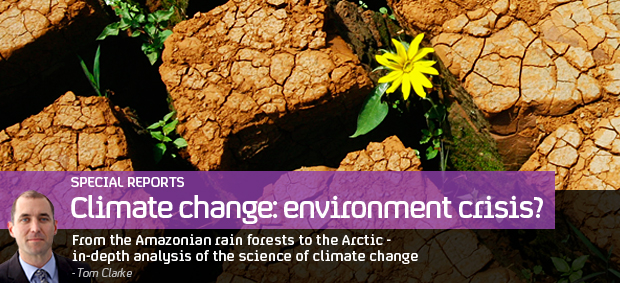Melting ice-cap: what has Greenland got to lose?
For some people Greenland’s melting ice-cap signals not only climate change but the end of a way of life, while to others it marks an opportunity for new investment. Tom Clarke meets both sides.
When we arrived in northern Greenland in the first week of October it was still raining. Typically the first snow would arrive at the end of August.
But native Greenlanders aren’t surprised at all. The “debate” about climate change isn’t something that happens here.
“I think it’s hard to find anyone in Greenland who doesn’t believe climate change is happening and happening at high speed,” Prime Minister of Greenland Kuupik Kleist, told Channel 4 News. “You only have to look out of the window to see something that something is going on.”
And this year was an exceptional one. Sea ice around Greenland and across the rest of the arctic retreated further then it ever has before. The vast ice-cap that covers central Greenland was also melting faster than ever before.
I think within a few years we will have at least four new mining operations in Greenland. Jonas Neilsen, former miner
“By mid July, the entire ice sheet was melting. That’s totally unprecedented,” said Alun Hubbard, a glaciologist at the University of Aberystwyth who is studying the Greenland Ice cap.
On 12 July one of Greenland’s few road bridges was swept away by unprecedented amounts of meltwater pouring off the ice cap. The bridge had stood since the 1950s. It’s a stark example of how destructive even gradual climate change can be.
Opportunity
Yet beneath Greenland’s vast ice cap and under its frigid oceans lies untold mineral and oil wealth. For an island nearly ten times the size of Britain, with a population equivalent to Tonbridge Wells, climate change brings huge economic opportunity.
There are many people within Greenland who argue: apart from ice, what has Greenland got to lose?
In 2010 British oil exploration firm Cairn Energy began looking for oil in off the coast of Western Greenland. They’re expected to return next year. Oil giants Shell and BP also have options to explore for oil in the region. The retreat of summer sea ice – combined with an increasing oil price – has made it worth their while.
And new mining firms are coming to explore newly ice-free areas of Greenland’s interior. “I think within a few years we will have at least four new mining operations in Greenland,” said former miner Jonas Neilsen. He is working with British firm Angel Mining, to re-open a lead and zinc mine near the hunting and fishing community of Uummannaq.
For Neilsen, more mines mean more jobs for native Greenlanders.
‘On thin ice’
But others feel a strong affinity for the traditional Greenlandic way of life. Using dogsleds, or even skidoos for hunting and visiting other remote communities, is part of Greenlandic tradition. But the dogsled season, which once lasted six months of the year, can sometimes be as short as six weeks.
Ole Jurgen Hammeken, former lawyer, explorer and star of a new film about the power of Inuit tradition tells me their culture faces a dual threat. First from climate change, then the human changes it brings – foreign investment, workers and wealth.
“I’ve felt for the last few years how present the ‘big world’ is.
“It’s getting interested in our minerals and our oil and we’re on thin ice in every sense of the word.”
The speed at which the climate is changing and investment from the outside world could rush into Greenland forces a stark admission from its Prime Minister Kuupik Kleist. I ask if his country can adapt fast enough: “Not really,” he said.
“Being a nation dependent on living resources this is a very big change we have to adapt to.”
“We want to develop our economy and exploit mineral resources,” said Kleist. “The question is how we’re able to develop resources in a sustainable and environmentally friendly way.”
-
Latest news
-
Boy with profound learning disabilities reaches out of court settlement after abuse in residential school7m

-
India election: Modi rivals hit by string of raids and arrests7m

-
Can UK’s abandoned mines be used to build a greener future?5m

-
Sycamore Gap: Man pleads not guilty to felling iconic tree2m

-
‘Child poverty has not fallen since Tories came in’, says Gordon Brown5m

-





